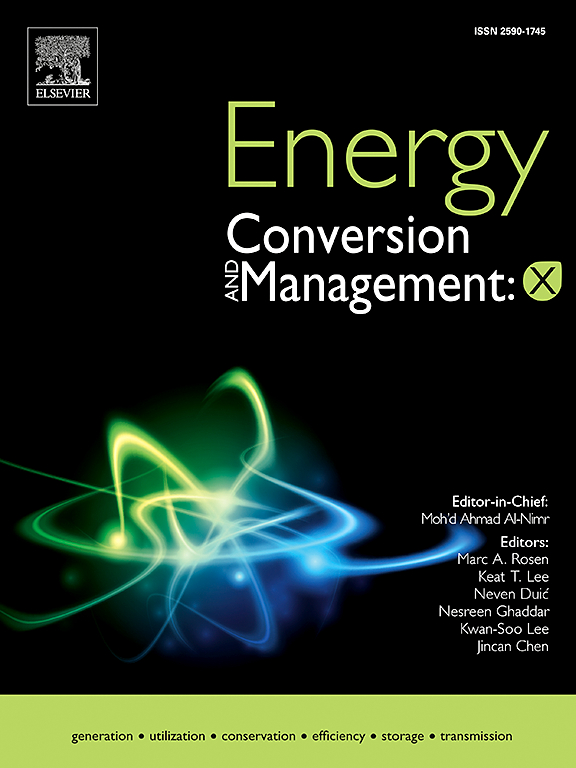Power-to-X in Southern Iraq: Techno-economic assessment of solar-powered hydrogen electrolysis combined with carbon capture and storage for sustainable energy solutions
IF 7.1
Q1 ENERGY & FUELS
引用次数: 0
Abstract
This study investigates the techno-economic feasibility of a Power-to-X (PtX) system by integrating solar-powered hydrogen electrolysis with carbon capture and Fischer-Tropsch (FT) synthesis processes for e-fuel production in Basra, Iraq. To this aim, a comprehensive modeling framework is developed to cover the detailed simulation of E-fuel production along with the system cost analysis. The proposed PtX system is supposed to be located near the Hartha power plant, which is one of the main sources of electricity in the Basra region, allowing for the utilization of captured CO2 from the power plant’s exhaust gas. The PtX plant design shows significant potential, producing 2.44 tonnes of (C12-C20) hydrocarbons and 3.36 tonnes of (C21-C40) heavy oils annually. This is achieved by utilizing 7.5 and 74.2 tonnes per year of hydrogen generated from solar electrolysis and captured CO2, respectively. A cash flow analysis covering 25 years shows that an E-fuel market price of $10 per liter is needed to achieve a positive cash flow within 15 years. The study also indicates that implementing a $200 per tonne carbon tax improves the economic feasibility of the project by allowing for earlier positive cash flows from 6 years and a quicker break-even point at the current E-fuel market price of $2 per liter with a NPV of $ 464 million. Sensitivity analysis reveals that higher carbon taxes and e-fuel prices enhance profitability by reducing payback periods and increasing the NPV. However, an increase in hydrogen production costs introduces substantial risk, with higher costs decreasing economic viability. The feasibility assessment suggests that despite the substantial initial investment needed for various system components, the long-term advantages include reduced CO2 emissions and the potential for Iraq to emerge as a leader in renewable fuel production. Stable policies, robust carbon taxes, and cost-efficient hydrogen production are essential for the successful implementation of PtX project.
伊拉克南部的电力到x:太阳能氢电解与碳捕获和储存相结合的可持续能源解决方案的技术经济评估
在伊拉克巴士拉,本研究通过将太阳能氢电解与碳捕获和费托合成工艺相结合,研究了电力到x (PtX)系统的技术经济可行性。为此,开发了一个全面的建模框架,以涵盖电子燃料生产的详细模拟以及系统成本分析。拟议的PtX系统应该位于Hartha发电厂附近,该发电厂是巴士拉地区的主要电力来源之一,允许利用从发电厂废气中捕获的二氧化碳。PtX工厂的设计显示出巨大的潜力,每年生产2.44吨(C12-C20)碳氢化合物和3.36吨(C21-C40)重油。这是通过每年分别利用7.5吨和74.2吨太阳能电解产生的氢气和捕获的二氧化碳来实现的。一项涵盖25年的现金流分析表明,要在15年内实现正现金流,电子燃料的市场价格需要达到每升10美元。该研究还表明,实施每吨200美元的碳税可以提高项目的经济可行性,因为它可以实现6年的早期正现金流,并在当前每升2美元的电子燃料市场价格下实现更快的盈亏平衡点,净现值为4.64亿美元。敏感性分析表明,较高的碳税和电子燃料价格通过缩短投资回收期和增加NPV来提高盈利能力。然而,氢气生产成本的增加带来了巨大的风险,成本上升会降低经济可行性。可行性评估表明,尽管各种系统组件需要大量的初始投资,但长期优势包括减少二氧化碳排放,并有可能使伊拉克成为可再生燃料生产的领导者。稳定的政策、强有力的碳税和具有成本效益的制氢是成功实施PtX项目的关键。
本文章由计算机程序翻译,如有差异,请以英文原文为准。
求助全文
约1分钟内获得全文
求助全文
来源期刊

Energy Conversion and Management-X
Multiple-
CiteScore
8.80
自引率
3.20%
发文量
180
审稿时长
58 days
期刊介绍:
Energy Conversion and Management: X is the open access extension of the reputable journal Energy Conversion and Management, serving as a platform for interdisciplinary research on a wide array of critical energy subjects. The journal is dedicated to publishing original contributions and in-depth technical review articles that present groundbreaking research on topics spanning energy generation, utilization, conversion, storage, transmission, conservation, management, and sustainability.
The scope of Energy Conversion and Management: X encompasses various forms of energy, including mechanical, thermal, nuclear, chemical, electromagnetic, magnetic, and electric energy. It addresses all known energy resources, highlighting both conventional sources like fossil fuels and nuclear power, as well as renewable resources such as solar, biomass, hydro, wind, geothermal, and ocean energy.
 求助内容:
求助内容: 应助结果提醒方式:
应助结果提醒方式:


